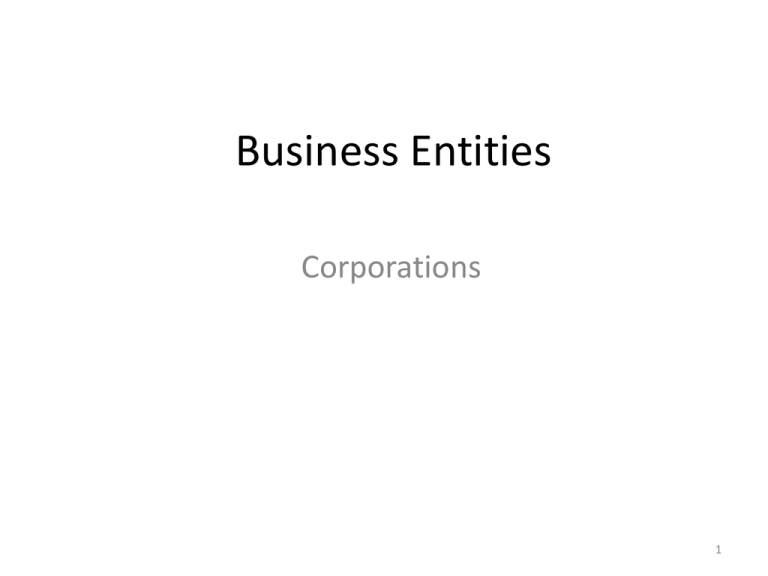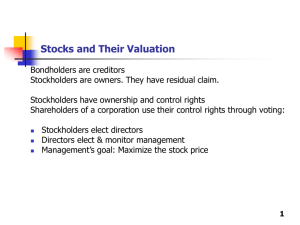Slide 4
advertisement

Business Entities Corporations 1 Corporations: “creatures of state law” • Business entities’ structures are primarily determined by state law. • People organizing businesses can choose which state’s laws to use. • Federal laws on business structures are mostly for publicly-traded companies. – Other federal laws affect all businesses the same way they affect individuals: tax laws, anti-discrimination laws, etc. 2 Why Corporations? Suppose Joan owns/operates as sole proprietor a software company specializing in providing ecommerce solutions for small businesses. To finance planned expansion and cash-in on the value of her business, Joan plans to sell 45% of ownership to a small group of institutional investors and 45% of ownership to approximately 750 geographically dispersed individual investors. Joan will retain 10% ownership and will continue her active management role in the firm. What form of business organization makes sense? 3 • Relationships among the people who are part of the business structure are largely governed by state law: – Equity owners – Debt holders – Managers – Employees • “Internal affairs doctrine”- state law controls to generally allow directors to structure business as they think best. 4 Solving the Problem • Corporate form solves problems that exist in partnership form of organization: – Unlimited personal liability – Equal participation in management – Inefficient voting rules – Dissolution at-will and restrictions on transferring ownership – Decentralized agency power 5 Corporation • • • • • Separate legal entity. Limited liability of shareholders. Double taxation. Centralized management. Name must include “Inc.”, “Corp.”, etc. 6 Delaware: Top Location for Large Corporations’ Place of Incorporation • 850,000 + business entities • > 50% all publicly traded corporations • > 60% of Fortune 500 legally incorporated there • 49th largest • 45th most populous • • 0.43% of US GDP (TX is 7.95%) 2nd in GDP per capita 7 Why DE? • Delaware corporate law is “best” • Delaware business courts (court of chancery) is “best” – Experienced judges – No juries 8 • Delaware’s preeminence in the corporate charter market results from its ability to resolve credibly the commitment problem in relational contracting. This ability depends on investing in assets, referred to as transaction-specific assets, whose value is highest when used in a specific relations rather than in any other use. – Reputation – Hostage-like dependence on revenue – Judicial expertise in interpreting corporate law, case law – Administrative expertise in rapid processing 9 Efficient Regulation • Delaware provides – Efficient court system with expert judges and no juries in corporate law cases. – Experienced service providers in a cluster. – Widespread knowledge of DE law among lawyers nationally and internationally. – Good service. – Commitment to maintaining quality because of DE’s dependence on revenue, huge sunk cost investment in corporate law; strong interest group of lawyers & service providers committed to keeping business. 10 • To establish a corporation—need: • Articles of incorporation ~ constitution – Total shares; classes of shares; powers of board, shareholders; preemptive rights; indemnity for directors. • Bylaws ~ statutes, set by directors – Procedures for meetings (notice, quorum), duties of officers, rules of governance. 11 Shareholders Board of Directors Officers 12 Shareholder ABC, Inc. Shareholder Shareholder XYZ, Inc. Shareholder Shareholder Shareholder 13 Who decides? • Where the next store will be located? • Whether a new type of sandwich should be offered? • Whether McDonald’s should begin operations in China? • Whether McDonald’s will buy Wendy’s? • Whether McDonald’s should liquidate the company? 14 • Dell’s Corporate Governance Principles • The Board of Directors (the “Board”) of Dell Inc. (“Dell”), as representatives of the stockholders, is committed to the achievement of business success and the enhancement of long-term stockholder value with the highest standards of integrity and ethics. In that regard, the Board has adopted these principles to provide an effective corporate governance framework for Dell, intending to reflect a set of core values that provide the foundation for Dell’s governance and management systems and its interactions with others. 15 • Easterbrook & Fischel, The Economic Structure of Corporate Law “The first question facing entrepreneurs is what promises to make, and the second is how to induce investors to believe them. Empty promises are worthless promises. Answering the first question depends on finding ways to reduce the effects of divergent interests; answering the second depends on finding legal and automatic enforcement devices. The more automatic the enforcement, the more investors will believe the promises.” (p. 5) 16 • Debt and Equity • “Entrepreneurs make promises in the articles of incorporation and the securities they issue when they go public. The debt investors receive … detailed promises in indentures. These promises concern the riskiness of the firm’s operations, the extent to which earnings may be paid out, and the domain of managerial discretion. These promises benefit equity investors as well as debt investors. The equity investors usually receive votes rather than explicit promises.” (p. 6) 17 Equity: Stock • Common stock: right to vote and receive distributions • Preferred stock: first call on dividends and distributions, usually non-voting • Convertible • Securities laws apply to public sales 18 • Authorization of shares - how many? Not the same as “issued” • Dilution – A, B, & C each own 1,000 shares – 1,000 new shares issued and sold to D • Preemptive rights: to pro rata share of new stock 19 Determining Shares to Issue • Legal attributes of shares reduce cost of the market for investment. – Model Business Corporation Act (MBCA) s6.01(a) requires shares within a class to have same preferences, limitations, & relative rights; DE GCL does not but DE common law does. – Need one class with unconditional voting rights and a class that is residual claimant on assets. 20 Determining Voting Rights • 2 potentially incompatible goals – Maximizing shareholders’ collective right to select directors – Protecting the rights of minority shareholders or groups of shareholders to have their views represented by directors of their choice. 21 Straight vs. cumulative voting • 3 shareholders: A (250), B (300), C (650) • 4 directors to be elected A Slate B Slate C Slate Straight voting 250 per candidate 300 per candidate 650 per candidate Cumulative voting 1000 total votes, cast all for A1 1200 total votes, cast all for B1 2600 votes, cast 1001 for C1, 1201 for C2, now must divide remaining 398 among C3 & C4 22 • X = [ ( Y * W) / (N + 1) ] + 1 • N: total number of directors to be elected • Y: total number of shares outstanding • W: number of directors a shareholder wants to elect • X: number of shares to elect the desired number of directors 23 Voting Rules • Acme, Inc. has 1000 voting shares outstanding. • Shareholders holding 600 shares are present at annual meeting. • Board recommends 2 amendments to articles of incorporation: – Change name to Ajax, Inc. (250 Y, 100 N, 250 A) – Abolish shares’ preemptive rights (450 Y, 125 N, 25 A) • Current MBCA – both pass • Older MBCA – 1 passes, 2 does not b/c type of amendment that triggers appraisal rights. Must pass by majority of outstanding shares entitled to vote (501) instead of majority present. • DGCL – both fail • Abstentions ignored under MBCA, treated as N under DE • MBCA 7.25(c) vs. DGCL 216 24 Fiduciary Duty & Voting Rules • Real case: Northern States Power Co. had 14 directors, elected annually to 1 year terms by cumulative voting. • Outsiders sought to elect Smaby to the board member. • Board opposed Smaby and sought to prevent her election by: – Reducing number of directors from 14 to 12. – Classifying board into 3 groups with 3 year staggered terms, so that just 4 directors elected each year. – Under old rules, Smaby needed cumulative votes of ~7% of shares to win; changes made that ~20%. • Despite unilateral power to change election rules, still a violation of fiduciary duty because changed rules in middle of campaign, without disclosure, and for purpose of defeating Smaby. • An otherwise lawful board action can be illegal if undertaken in the middle of the campaign to stop dissident shareholders from elect a 25 representative. Purpose of voting • Firms with small number of shareholders, all with access to information, and homogenous preferences: voting as exercise of management power. • Controlling shareholder firms, where shareholder has access to info and incentive to cast informed vote: managerial and oversight function because can vote management out. • Dispersed shareholders without information or incentive to vote, then: – Voting is “simply one of many corporate accountability mechanisms-and not a very important one at that.” – “The corporation is simply a vehicle by which the board of directors hires capital by selling equity and debt securities to risk-bearers with varying tastes for risk.” 26 Directors as “Guardians” • “One of the most basic tenets of Delaware corporate law is that the board of directors has the ultimate responsibility for managing the business and affairs of a corporation. Section 141(a) requires that any limitation on the board’s authority be set out in the certificate of incorporation.” Quickturn Design Systems, Inc. v. Shapiro, 721 A.2d 1281 (Del. 1998). • Principle behind – – – – Business judgment rule Limits on shareholder derivative litigation Limits on shareholder voting rights Board power to resist unsolicited takeover offers • Justifies strong skepticism of the validity of shareholder adopted bylaws which restrict management discretion.27 Corporate Problem: Double Taxation Roger Co., Inc. Profits = $100 Corp. Tax @ 35% Net = $65 Roger Co., Inc. Dividend pays $65 divided among 4 shareholders Shareholders A B C D D taxed @ 35%+ Dividend rec’d = $16.25 Net = $10.56 each 28 Double Taxation Roger Co., Inc. Profits = $100 Corp. Tax @ 35% Net = $65 Roger Co., Inc. Dividend paid of $0 Total stock value rises by $65 Shareholders A B C D Dividend capital gains taxed @ 15% Cap Gain of $16.25 Net = $13.80 each when realize Capital Gain 29 Duties of Corporate Officers & Directors • Business Judgment Rule: Schlensky v. Wright (Chicago Cubs night game case) • Smith v. Van Gorkom - Duty of Care - 2 hour meeting not enough – Led to practice of “fairness opinions” – Delaware amended corporate law to permit shielding of directors from personal liability. 30 • Breach of duty by inaction: failure to monitor • Duty of Loyalty – Is the transaction within the interested director provisions of state statute? – If so, has the statute been complied with (disclosure, permission, etc.)? – What is the effect of the statute? 31 • Breach of duty by inaction: failure to monitor • Duty of Loyalty – Is the transaction within the interested director provisions of state statute? – If so, has the statute been complied with (disclosure, permission, etc.)? – What is the effect of the statute? 32 • “Ultra vires” - acts beyond the power of the corporation. – General charters have made it less important. • “Subchapter S election” - avoid double taxation but give up ability to avoid individual tax on retained assets. 33






